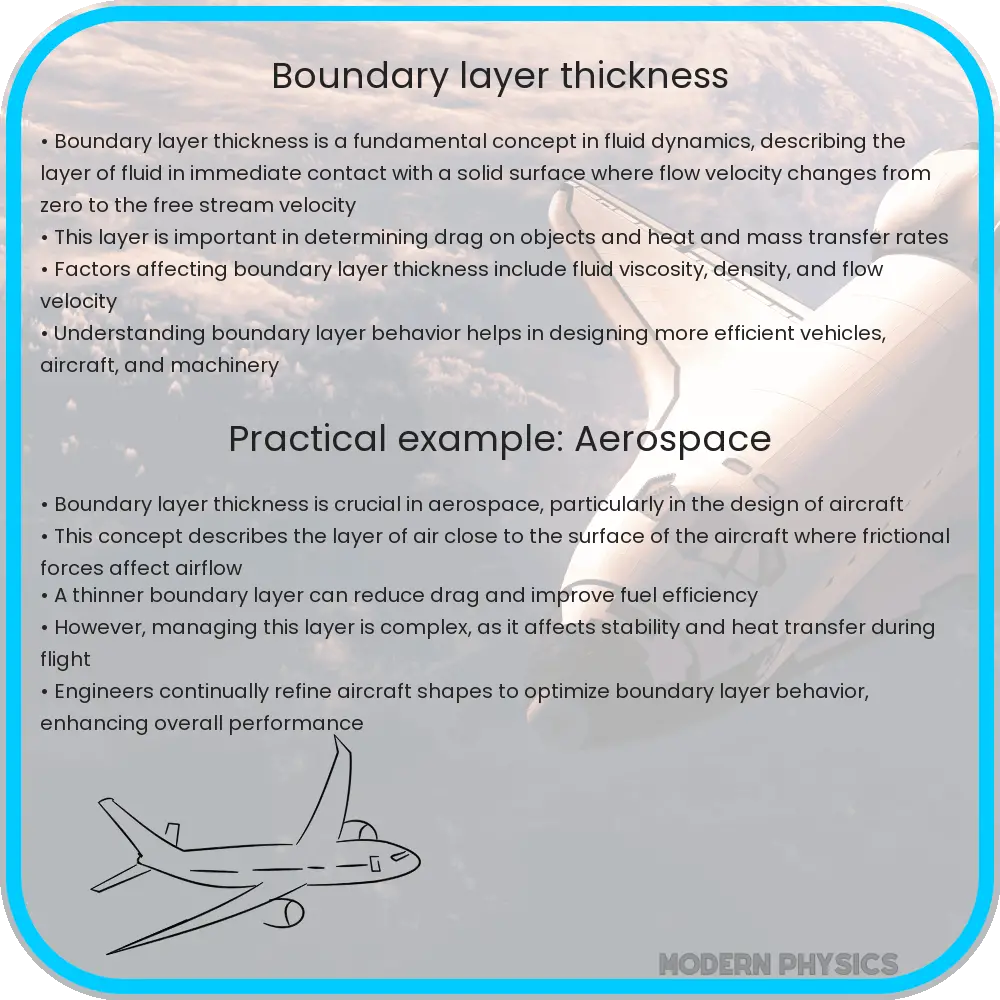Explore boundary layer thickness in fluid dynamics: its measurement, effects, control techniques, and applications in various industries.

Understanding Boundary Layer Thickness in Fluid Dynamics
The concept of boundary layer thickness is pivotal in the study of fluid dynamics, influencing various engineering and scientific applications. This layer, forming at the interface where a fluid flows over a surface, plays a crucial role in determining the behavior of the flow, especially in terms of friction, heat transfer, and aerodynamic drag.
Measurement of Boundary Layer Thickness
Measuring the boundary layer thickness is essential for understanding and predicting fluid flow characteristics. The thickness is typically defined as the distance from the solid surface to a point in the fluid where the velocity reaches 99% of the freestream velocity. Common measurement techniques include:
- Pitot tube: A simple yet effective method, where the tube measures the pressure difference to infer velocity profiles.
- Laser Doppler Anemometry (LDA): A more advanced technique utilizing laser beams to measure the velocity of particles within the fluid.
- Hot-wire anemometry: Suitable for high-resolution measurements, this method involves a thin wire heated above the fluid temperature and analyzing the cooling effect due to the fluid flow.
Effects of Boundary Layer Thickness
The thickness of the boundary layer has significant effects on:
- Friction Drag: A thicker boundary layer often means increased friction between the fluid and the surface, impacting the efficiency of vehicles like airplanes and ships.
- Heat Transfer: The rate of heat transfer between the surface and the fluid is affected by the boundary layer characteristics.
- Aerodynamic Performance: In aerodynamics, the boundary layer influences lift and drag forces on aircraft wings.
Control of Boundary Layer Thickness
Controlling the boundary layer thickness is vital in many engineering applications. Techniques include:
- Surface Roughness: Modifying the surface texture can either enhance or reduce the boundary layer thickness.
- Vortex Generators: Small aerodynamic devices that create vortices to energize the boundary layer and delay flow separation.
- Suction and Blowing: Removing or adding fluid at the surface to modify the boundary layer characteristics.
Understanding and manipulating the boundary layer thickness can lead to advancements in various fields, including aerospace, automotive, and marine engineering. The ongoing research and development in this area continue to push the boundaries of fluid dynamics, offering innovative solutions to complex flow-related challenges.
Advanced Techniques in Boundary Layer Control
To further optimize the control of boundary layer thickness, scientists and engineers employ several advanced techniques. These include:
- Boundary Layer Transition Devices: These are designed to control the transition from laminar to turbulent flow, which can significantly affect the boundary layer thickness and its properties.
- Compliant Surfaces: Inspired by the skin of fast-swimming sharks, these surfaces adapt to fluid flow to minimize drag and control the boundary layer effectively.
- Fluidic Inserts: By injecting fluid at strategic locations, these inserts can manipulate the boundary layer to achieve desired flow characteristics.
Applications and Imp
lications of Boundary Layer Control
Effective control of boundary layer thickness has a wide range of applications:
- Aerospace Industry: Improved aircraft performance, reduced fuel consumption, and enhanced safety through better control of aerodynamic drag and lift.
- Maritime Engineering: In ship design, controlling the boundary layer reduces hydrodynamic drag, leading to more efficient and eco-friendly vessels.
- Automotive Sector: Enhanced vehicle aerodynamics for improved fuel efficiency and reduced emissions.
- Wind Energy: Optimization of wind turbine blade designs for maximum efficiency and energy output.
Future Trends and Research
Research in boundary layer dynamics is continuously evolving. Future trends include:
- Nanotechnology: Utilizing nanomaterials for surface coatings to dynamically control boundary layer properties.
- Machine Learning and AI: Implementing artificial intelligence to predict and optimize boundary layer behavior in real-time applications.
- Environmentally Sustainable Practices: Developing techniques that reduce environmental impact, such as lowering noise pollution and emissions in transportation sectors.
Conclusion
The study and manipulation of boundary layer thickness are fundamental to advancing our understanding and capabilities in fluid dynamics. From improving the efficiency of various transportation modes to contributing to sustainable practices, the implications are vast and deeply impactful. As technology advances, particularly with the integration of AI and nanotechnology, the potential for innovation in this field is immense. Embracing these advancements will not only lead to technological breakthroughs but also help in addressing some of the critical environmental challenges facing our world today.
